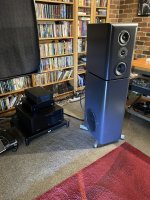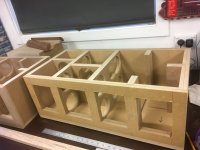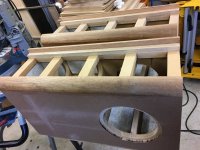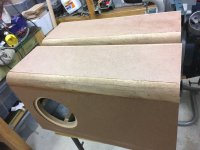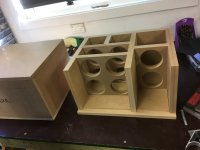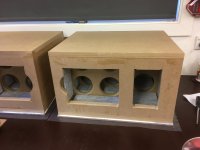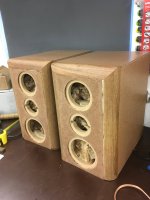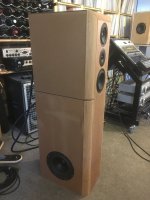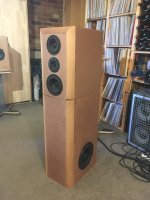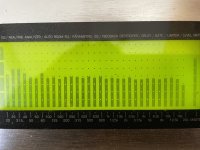In recent threads:
https://www.diyaudio.com/community/...crossover-frequency-in-the-near-field.401809/
https://www.diyaudio.com/community/...er-w-pd-21-drivers.402264/page-5#post-7433034
there is some discussion of the benefits of side-firing woofers. So I thought I would describe a recently completed build of mine which employs this method of woofer mounting. I have borrowed ideas from past commercial loudspeakers such as the AR9, NHT 3.3, various vintage Allison Acoustics models.
These are the features of my build that are unusual from a typical commercial enclosure:
1. Separate isolated sub-woofer enclosure, with reaction cancelling drivers.
2. 2” edge round-overs for diffraction effects control.
3. Low sub-woofer position for enhanced room boundary bass re-inforcement.
4. Tri-laminate layer (mdf/mdf/hardboard) 1.25” panels for increased rigidity.
The drivers chosen are:
sub-woofer 8" SB23MFCL45-8 (x2 in parallel), mid-woofer 5” SB15CRC30-8, upper-mid 4” SB12MNRX2-4, tweeter SB26STAC-C000-4.
I have a great respect for SB Acoustics drivers. They have great build quality, good performance and are affordable. My previous builds have used ScanSpeak drivers, but ScanSpeak prices have increased beyond my comfort zone for DIY, and I find the SB range comparable in performance. The SB drivers are affordable and offer a wide range of cone materials in the same driver format so that they can be compared to decide on a preference.
The 4” SB12MNRX2-4 upper-mid is the only dedicated mid-range driver in the standard SB range, with shortened voice coil and linear travel compared to their 4” mid-woofers and is suitable for a 4-way, where it can be high-passed crossed over well above the bass frequencies.
The 5” SB15CRC30-8 mid-woofer was chosen after comparing listening tests with the Norex and aluminium cone versions. The cone material is a Rohacell/carbon fibre laminate.
The upper enclosure is a compact sealed 3-way, decoupled from a sealed sub-woofer enclosure by 50mm diameter Sorbothane hemispheres. The chosen dimensions keep the tweeter-floor height at 1m, which is right for my listening position.
https://www.diyaudio.com/community/...crossover-frequency-in-the-near-field.401809/
https://www.diyaudio.com/community/...er-w-pd-21-drivers.402264/page-5#post-7433034
there is some discussion of the benefits of side-firing woofers. So I thought I would describe a recently completed build of mine which employs this method of woofer mounting. I have borrowed ideas from past commercial loudspeakers such as the AR9, NHT 3.3, various vintage Allison Acoustics models.
These are the features of my build that are unusual from a typical commercial enclosure:
1. Separate isolated sub-woofer enclosure, with reaction cancelling drivers.
2. 2” edge round-overs for diffraction effects control.
3. Low sub-woofer position for enhanced room boundary bass re-inforcement.
4. Tri-laminate layer (mdf/mdf/hardboard) 1.25” panels for increased rigidity.
The drivers chosen are:
sub-woofer 8" SB23MFCL45-8 (x2 in parallel), mid-woofer 5” SB15CRC30-8, upper-mid 4” SB12MNRX2-4, tweeter SB26STAC-C000-4.
I have a great respect for SB Acoustics drivers. They have great build quality, good performance and are affordable. My previous builds have used ScanSpeak drivers, but ScanSpeak prices have increased beyond my comfort zone for DIY, and I find the SB range comparable in performance. The SB drivers are affordable and offer a wide range of cone materials in the same driver format so that they can be compared to decide on a preference.
The 4” SB12MNRX2-4 upper-mid is the only dedicated mid-range driver in the standard SB range, with shortened voice coil and linear travel compared to their 4” mid-woofers and is suitable for a 4-way, where it can be high-passed crossed over well above the bass frequencies.
The 5” SB15CRC30-8 mid-woofer was chosen after comparing listening tests with the Norex and aluminium cone versions. The cone material is a Rohacell/carbon fibre laminate.
The upper enclosure is a compact sealed 3-way, decoupled from a sealed sub-woofer enclosure by 50mm diameter Sorbothane hemispheres. The chosen dimensions keep the tweeter-floor height at 1m, which is right for my listening position.
Attachments
Last edited:
Very cool. What are the overall dimensions of the cabinets? If you had your time again, knowing what you know now, what would you do differently? 😉
I paid the usual attention to internal bracing, interior panel damping, fibreglass enclosure stuffing, driver flush rebates. The overall wall tri-laminate thickness is 1.25”. In the past I have used constrained layer panels, but I have found that stiff, braced panels together with reaction-cancelling, reduces the woofer enclosure excitation to a greater degree, without the significant weight penalty and complex panel jointing.
I found that two 1/2” mdf panels glued together with PVA glue, results in a stiffer panel than a single sheet of 1” mdf. Adding 1/4” hardwood stiffenss the panel further. I tested this empirically with tap tests on identical size test panels. The resulting test impacts audibly went from “bonk” (mdf) to “pock” (mdf/mdf/hardwood tri-laminate). There was an audible difference in the decay. I did no measurements, just used my ears.
All panels and interior braces are connected by 6mm rebated glue joints. The images show the partial dry assembly fitting of panels and braces.
My driver choices were guided by extensive listening comparisons with different versions of each driver from the SB range. There was not a lot of measured differences but certain preferences arose after installing and listening to the drivers. In some cases, up to 3 sets of drivers were compared before finalising.
The side mounted sub-woofer frames are connected through the mounting holes by 4mm tensioned threaded steel rods. This may not be as efficient reaction cancelling as rigidly connecting the magnets, but is relatively easy to implement. It could be argued that in any case, reaction cancelling at the driver/enclosure interface is the goal.
The crossover is active dsp 192/24 with LR24 and LR48 crossover topologies. The drivers are phase aligned at crossover by delay. Crossover frequencies are 80 hz, 320 hz, 2560 hz.
I found that two 1/2” mdf panels glued together with PVA glue, results in a stiffer panel than a single sheet of 1” mdf. Adding 1/4” hardwood stiffenss the panel further. I tested this empirically with tap tests on identical size test panels. The resulting test impacts audibly went from “bonk” (mdf) to “pock” (mdf/mdf/hardwood tri-laminate). There was an audible difference in the decay. I did no measurements, just used my ears.
All panels and interior braces are connected by 6mm rebated glue joints. The images show the partial dry assembly fitting of panels and braces.
My driver choices were guided by extensive listening comparisons with different versions of each driver from the SB range. There was not a lot of measured differences but certain preferences arose after installing and listening to the drivers. In some cases, up to 3 sets of drivers were compared before finalising.
The side mounted sub-woofer frames are connected through the mounting holes by 4mm tensioned threaded steel rods. This may not be as efficient reaction cancelling as rigidly connecting the magnets, but is relatively easy to implement. It could be argued that in any case, reaction cancelling at the driver/enclosure interface is the goal.
The crossover is active dsp 192/24 with LR24 and LR48 crossover topologies. The drivers are phase aligned at crossover by delay. Crossover frequencies are 80 hz, 320 hz, 2560 hz.
Attachments
I set up with the best crossover phase matching I can achieve, essentially flat on axis. In one important way, these loudspeakers sound different from my many previous builds. They seem to drive the room differently. There is a distinct reduction in low frequency acoustic output to the sides of the enclosure. This is due to the bipole effect of the subwoofer mounting.
This means that sub frequencies (< 80 Hz) are attenuated towards the sidewall. A subjective effect of this appears to be less soundstage width than I am used to. The outside-the-speaker imaging seems to occur less frequently than I experience with front baffle mounted drivers. Why there should be such a difference with the subs only operating over such a limited frequency range, I don’t know. However Stereophile
did discuss a similar effect for the NHT 3.3. Maybe it is a property of the upper enclosure driver arrangement, which is similar but the woofer is single in the NHT 3.3.
With very little EQ, the frequency response at the listening position is as shown. The peak at 50 Hz is probably mains hum since the RTA mic gain is very high. The roll-off at 20 kHz is untypical when measured at 1m on axis. The system easily reaches to 20 Hz with no EQ, which is surprising to me with only 2x8" sub-woofers. I think the floor boundary is the reason. The dsp crossover allows very good phase matching at the listening position between the sub-woofers and the 5" mid-woofer. This would be much harder to do with a passive crossover because of the large spacing between the sub-woofers and the upper enclosure. Also a passive 80 hz crossover would require some humongous, expensive coils. I have used active x-overs for over a decade and no way will I go back to passive.

This means that sub frequencies (< 80 Hz) are attenuated towards the sidewall. A subjective effect of this appears to be less soundstage width than I am used to. The outside-the-speaker imaging seems to occur less frequently than I experience with front baffle mounted drivers. Why there should be such a difference with the subs only operating over such a limited frequency range, I don’t know. However Stereophile
did discuss a similar effect for the NHT 3.3. Maybe it is a property of the upper enclosure driver arrangement, which is similar but the woofer is single in the NHT 3.3.
With very little EQ, the frequency response at the listening position is as shown. The peak at 50 Hz is probably mains hum since the RTA mic gain is very high. The roll-off at 20 kHz is untypical when measured at 1m on axis. The system easily reaches to 20 Hz with no EQ, which is surprising to me with only 2x8" sub-woofers. I think the floor boundary is the reason. The dsp crossover allows very good phase matching at the listening position between the sub-woofers and the 5" mid-woofer. This would be much harder to do with a passive crossover because of the large spacing between the sub-woofers and the upper enclosure. Also a passive 80 hz crossover would require some humongous, expensive coils. I have used active x-overs for over a decade and no way will I go back to passive.
Top box 285x405x450 (WxDxH), lower box 285x405x720.Very cool. What are the overall dimensions of the cabinets?
The dimensions were finalised to allow the tweeter height at 1m. The sub-woofer enclosure internal volume is ~75 L.
Not much differently.If you had your time again, knowing what you know now, what would you do differently? 😉
I have had great consistent results with the fabric dome tweeter. I am quite picky about tweeters and I can't say the ScanSpeak Revelator tweeters I have used previously, sound better.
I do have a curiosity around the Satori 2.5" dome midrange
https://sbacoustics.com/wp-content/uploads/2022/03/2.5in-SATORI-MD60N-6.pdf
used in place of the 4" midrange.
https://sbacoustics.com/wp-content/uploads/2021/03/4in-SB12MNRX2-25-4.pdf
Also, would the 6" mid-bass
https://sbacoustics.com/wp-content/uploads/2020/02/6in-SB17CRC35-8.pdf
improve on the 5"? The original selection was driven by the intention to keep everything as compact as I could manage. As I get more feeble, the big monkey coffins lose much of their appeal, regardless of how good they sound. My experience is that the larger cone drivers have a bit more dynamic presentation. I don't think this is always due to resonance or cone break-up as I hear it even at low spl. I would like to give it an audition because the Rohacell/carbon cone drivers have a smooth sound to my ears. Reminiscent of those Vifa/Peerless polycone midrange drivers from last century.
could I ask where you got your corner roundover sections ? I assume you bought in if not hoe did you make them ? km doing something similar and have got myself a 1.5inch roundover bit but mitreing hardwood strips sounds like a lot less work !!I paid the usual attention to internal bracing, interior panel damping, fibreglass enclosure stuffing, driver flush rebates. The overall wall tri-laminate thickness is 1.25”. In the past I have used constrained layer panels, but I have found that stiff, braced panels together with reaction-cancelling, reduces the woofer enclosure excitation to a greater degree, without the significant weight penalty and complex panel jointing.
I found that two 1/2” mdf panels glued together with PVA glue, results in a stiffer panel than a single sheet of 1” mdf. Adding 1/4” hardwood stiffenss the panel further. I tested this empirically with tap tests on identical size test panels. The resulting test impacts audibly went from “bonk” (mdf) to “pock” (mdf/mdf/hardwood tri-laminate). There was an audible difference in the decay. I did no measurements, just used my ears.
All panels and interior braces are connected by 6mm rebated glue joints. The images show the partial dry assembly fitting of panels and braces.
My driver choices were guided by extensive listening comparisons with different versions of each driver from the SB range. There was not a lot of measured differences but certain preferences arose after installing and listening to the drivers. In some cases, up to 3 sets of drivers were compared before finalising.
The side mounted sub-woofer frames are connected through the mounting holes by 4mm tensioned threaded steel rods. This may not be as efficient reaction cancelling as rigidly connecting the magnets, but is relatively easy to implement. It could be argued that in any case, reaction cancelling at the driver/enclosure interface is the goal.
The crossover is active dsp 192/24 with LR24 and LR48 crossover topologies. The drivers are phase aligned at crossover by delay. Crossover frequencies are 80 hz, 320 hz, 2560 hz.
@jccart
If you look in the top left of the first photo in post #3, you will see offcuts of 2" quad round hardwood. It is a standard timber moulding in Oz, but usually only sold at a proper timber yard. I have a router table and would prefer to make my own but I never found a 1/2" rounder bit of that size. I never use pine because it dents easily at the slightest nudge.
If you look in the top left of the first photo in post #3, you will see offcuts of 2" quad round hardwood. It is a standard timber moulding in Oz, but usually only sold at a proper timber yard. I have a router table and would prefer to make my own but I never found a 1/2" rounder bit of that size. I never use pine because it dents easily at the slightest nudge.
hi bon, nice speakers - but i am curious, do you have other response curves other than that in post 4 ?
thanks I thought I had already replied to this never mind . thanks what do they use them for over there I've never seen anything like this in the UK. I managed to find some mdf ones but hardwood would be nice and durable like you say@jccart
If you look in the top left of the first photo in post #3, you will see offcuts of 2" quad round hardwood. It is a standard timber moulding in Oz, but usually only sold at a proper timber yard. I have a router table and would prefer to make my own but I never found a 1/2" rounder bit of that size. I never use pine because it dents easily at the slightest nudge.
The response curve in post #4 is in phase pink noise through both channels at the seated listening position, mic straight ahead mid-way between the speakers.hi bon, nice speakers - but i am curious, do you have other response curves other than that in post 4 ?
Mic position is tweaked to give the least response to out-of-phase pink noise by equalising the distance to each tweeter. The responses contains room acoustic interference but gives a good idea of the subjective spectral balance. Shown at 1m on tweeter axis for a single speaker, the response is flatter. My ancient RTA is 1/3 octave at 48kHz/24bit, so the discrimination is below what is available nowadays. It gives me sufficient info to tune the system to my preference.
Broadband level changes of 0.5 dB are easy to hear comparatively, but won't be apparent on the RTA screen. My ears are always the final tool.
Attachments
Just an update for those who showed interest in this build. My main intention was to implement side mounted reaction cancelling woofers, and I am satisfied that my objectives have been met in this regard. As a side benefit, I was picky about the drivers used for the rest of the frequency range.
I was particularly pleased to discover that SB Acoustics have introduced an open source kit with exactly the same pairing of mid-range and tweeter. The designer must have heard the same synergy as I have.
https://sbacoustics.com/product/gema/
I have been using SB Acoustics drivers for many years and know their subjective performance very well. I have auditioned all of their current non-Satori 4", 5" and 6" mid-bass drivers and soft dome tweeters. My curiosity about the dedicated mid-range SB12MNRX2-25-4 was piqued and I found the subjective performance a step above the other mid-woofers. After extended listening to the pairings with the soft dome tweeters, I decided that the SB26STAC-C000-4 worked extremely well with the SB12MNRX2-25-4. When time/phase aligned with an active digital crossover at 2800 Hz, LR24, the pairing was as seamless as any I have achieved.
In post #2, I was asked what I would do differently. I have have repeatedly asked myself what more would I wish for. In my current listening space 6.5 x 6.7 x 2.4 m, nothing really comes to mind.
I was particularly pleased to discover that SB Acoustics have introduced an open source kit with exactly the same pairing of mid-range and tweeter. The designer must have heard the same synergy as I have.
https://sbacoustics.com/product/gema/
I have been using SB Acoustics drivers for many years and know their subjective performance very well. I have auditioned all of their current non-Satori 4", 5" and 6" mid-bass drivers and soft dome tweeters. My curiosity about the dedicated mid-range SB12MNRX2-25-4 was piqued and I found the subjective performance a step above the other mid-woofers. After extended listening to the pairings with the soft dome tweeters, I decided that the SB26STAC-C000-4 worked extremely well with the SB12MNRX2-25-4. When time/phase aligned with an active digital crossover at 2800 Hz, LR24, the pairing was as seamless as any I have achieved.
In post #2, I was asked what I would do differently. I have have repeatedly asked myself what more would I wish for. In my current listening space 6.5 x 6.7 x 2.4 m, nothing really comes to mind.
Last edited:
thanks for the update I might give this design a try not too expensive drivers to risk trying them
The Behringer DSP 8024 is only used for for RTA display. It is not in the system chain. I never used it for EQ. It is primitive by todays standard.
The mid-range SB12MNRX2-25-4 is the stand-out of the driver collection. I use it for an octave lower than the Gema passive crossover. This is because I wanted it to handle as much of the spectrum as it was comfortable with. OTOH it could be argued that with its mid-optimised design, it is important not to allow it to be exposed to low frequencies, and this may explain the 680Hz Gema high-pass corner frequency. I use 320 Hz LR24 high pass. Maybe the Gema passive crossover at 680 Hz is a less steep filter.thanks for the update I might give this design a try not too expensive drivers to risk trying them
The pairing with the SB26STAC-C000-4 tweeter with LR24 at 2800 Hz is exceptional. With no EQ on the tweeter and minimal EQ on the mid-range, the pair pretty much measures like a single driver when carefully phase aligned.
With the Gema kit, SB Acoustics have put together drivers with high potential for performance. I can't comment on their passive crossover, but with a good enclosure, the design looks encouraging. I prefer sealed bass enclosures, and this might alter the choice of bass driver and enclosure.
- Home
- Loudspeakers
- Multi-Way
- Active 4-way with reaction cancelling woofers
